
12 Days Tibet Trekking Tour from Nyenchen Tanglha Mountan to Namtso Lake
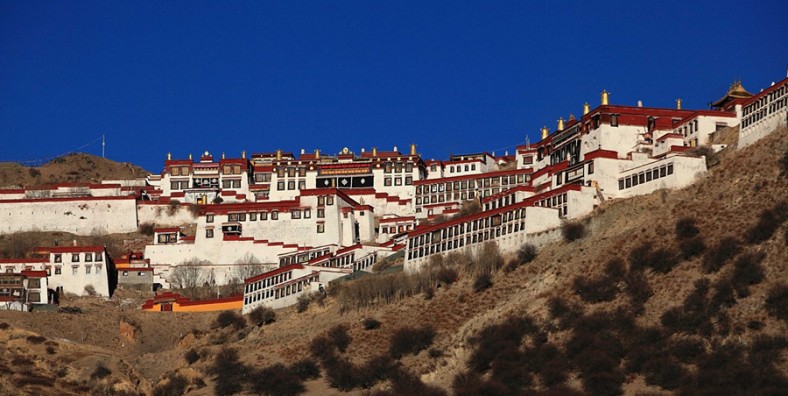
Tour Overview
This 12 Days Tibet Trekking Tour from Nyenchen Tanglha Mounrtain to Namtso Lake will take you to irst visit the city hifglights of Lhasa, experience the unique Tibetan Buddhism...
Code of Tour: YCT0000001826
Length of Travel: 12 Day
Destinations of Tour: Lhasa - Ganden Monastery - Damxung - Trekking - Namtso Lake - Yangpachen - Lhasa
Departure City: Lhasa
Price of Tour: Request
Type of Tour:
Features of Tour: Nature Hiking Culture History Landscape
This 12 Days Tibet Trekking Tour from Nyenchen Tanglha Mounrtain to Namtso Lake will take you to irst visit the city hifglights of Lhasa, experience the unique Tibetan Buddhism culture in the famous monasteries and palaces such as Potala palace and Jokhang temple. Then, start your trekking along the Qinghai-Tibet Highway to Namtso Lake, you can fully appreciate the Nychen Tanglha Mountain on your way. A number of stream crossings aside you. Fantastic views of sparkling Nam-tso and Tashi Do are visible from many vantage points on the trail,also, the green grassland and colorful nomad camps along the way.
Highlights:
- Experience Tibetan Buddhism in significant monasteries in Lhasa including Potala Palace.
- Trekk along the Qinghai-Tibet highway with the most beautiful sceneries passing by.
- Meet the tranquil lakes, white snow mounatians, shimmering rivers and rare animals on your way.
- Trekk to visit the sparking Namtso Lake and the charming Tashi peninsula.
Brief Itinerary
- Day 1: Lhasa Arrival
- Day 2: Lhasa
- Day 3: Lhasa
- Day 4: Lhasa-Gandan
- Day 5: Gandan-Reting
- Day 6: Reting-Damxung
- Day 7: Trekking
- Day 8: Trekking
- Day 9: Trekking to Namtso
- Day 10: Namtso
- Day 11: Namtso-Lhasa
- Day 12: Lhasa Departure
Google Map
Detailed Itinerary
Day 1 Arrival-Lhasa(3650m)
Sightseeing and Activities:Arrival-Lhasa(3650m)
Accommodation:Lhasa
Meals:None
Transfer to Lhasa downtown after arriving in Lhasa Gongar airport or the Lhasa train station. Have a rest in Lhasa to acclimatize the high altitude. Stay overnight in Lhasa.
Day 2 Lhasa Sightseeing
Sightseeing and Activities:Potala Palace,Jokhang Temple,Barkhor street, Sera Monastery
Accommodation:Lhasa
Meals:Breakfast, Lunch
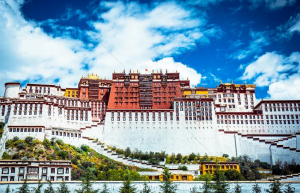
Go sightseeing inside Lhasa. Visit Potala palace first to explore the grandest of this myriad chapels, its audience halls, the jeweled and Golden burial chortens(stupa Tombs) of past Dalai Lamas, and tremendous number of Buddhist frescoes, thangkas, combinations of mandala, figures of the Buddha.
Then, visit the Johkang Temple, the spiritual center of Tibetan Buddhism, which attracts pilgrims all over Tibetan Area, built during songtsen gonpo’s reign by princess wencheng of tang dynasty, 647 A.D.
Day 3 Lhasa Sightseeing
Sightseeing and Activities:Potala Palace,Jokhang Temple,Barkhor street, Sera Monastery
Accommodation:Lhasa
Meals:Breakfast, Lunch
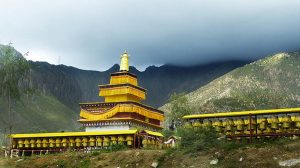
Go sightseeing inside Lhasa. Visit Monasteries Sera and Drepung Monastery, locate in suburb of Lhasa, are hosted by hundreds of Monks, learning, praying, studying, and living there. The famous Monks debiting held in the courtyard of Sera Monastery in the afternoon. Explore the circular pilgrim route barkhor while traveling at Johkang Temple, contact local folks, and if possible purchase some traditional Tibetan artifacts, religious implements, antiques, books, Tibetan music instrument, Thangkas, and tradition Tibetan clothes etc. Stay overnight in Lhasa.
Day 4 Lhasa-Gandan
Sightseeing and Activities:Tibetan Museum, Gandan Monastery
Accommodation: Gandan Monastery Guest House
Meals:Breakfast, Lunch
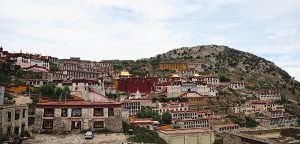
In the morning, visit Tibetan Museum (admission fee is free). After lunch drive to Ganden Monastery, built by Tsongkhaba in 1409 soon after the Monlam Festival was over. Gandan is one of the three main monasteries of Gelug Sect. Anyhow, different from Drepung and Sera, and it once played a more prominent political role in Tibetan history. The abbot of this monastery possess of a high religious position within the system of Gelug Sect, just inferior to Dalai and Panchan. The monastery was reconstructed in 1993 and restored to its original appearance. The holy stupa of Tsongkhaba is just in the monastery. Stay overnight in Ganden Monastery Guest House
Day 5 Ganden-Reting
Sightseeing and Activities:Reting Monastery
Accommodation:Camping
Meals:Breakfast, Lunch
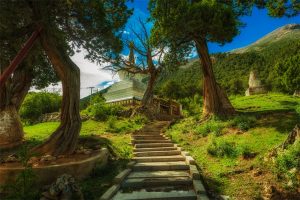
In the morning, head for Reting Monastery 180 kilometers north to Lhasa and have lunch on the way. The monastery Reting lies in the midst of an expanse of cypress forest. It was established in 1057 by Drom Toenpa, Atishas most important pupil. It was said the cypress forest had developed from a tuft of hair from Drom Toenpa, who buried that beneath the soil. The visitors can take part in such activities, like walking outside of the monastery, and hiking along the Lingkhor (outside Zhuanjing route; approx. 1 hour). In the afternoon, visit the Reting Monastery or villages down the Kyichu River valley. Camping tonight.
Day 6 Reting-Damxung
Sightseeing and Activities:Trekking
Accommodation:Camping
Meals:Breakfast, Lunch, Dinner
In the morning, drive on rugged road before reaching Damxung (4130 m) along the Qinghai-Tibet Highway, where our trek begin. Today we will not only have a short trek and go through a beautiful meadow, but also visit a monastery en route. Camping tonight.
Day 7 Trekking 7-8 hours
Sightseeing and Activities:Trekking 7-8 hours
Accommodation:Camping
Meals:Breakfast, Lunch, Dinner
Pass through glaciated valley and reach a herder’s camp, where we camp for the night. Camping tonight.
Day 8 Trekking 6-7 hours
Sightseeing and Activities:Trekking 6-7 hours
Accommodation:Camping
Meals:Breakfast, Lunch, Dinner
Cross Kong La from where you have spectacular views of Nam Tso Lake and the Nyenchen Thangla ranges. Descend to a broad basin and hike along green meadows. Camping tonight.
Day 9 To Tashi Dorje and Nam Tso Lake 7-8 hours
Sightseeing and Activities:To Tashi Dorje and Nam Tso Lake 7-8 hours
Accommodation:Camping
Meals:Breakfast, Lunch
Hike along green meadows and pass through several nomad camps and their herds of animals. Have lunch by the lake. Then follow the jeep trail all the way to Tashi Dorje hermitage. Nam Tso, the biggest salty lake of Tibet, is 70 kilometers long from east to west and 30 kilometers wide from north to south, covers an area of 1,920 square kilometers with an altitude of 4,700 meters above sea level. It is said the holy lake and the holy mountain Nyenchentangla are a couple of lovers, who guard the vast pasture and cattle together. Camping tonight.
Day 10 Nam Tso Lake
Sightseeing and Activities:Nam Tso Lake
Accommodation:Camping
Meals:Breakfast, Lunch
Explore the Tashi peninsula by walking around the holy hill, the cliffs of which have been eroded over the centuries. Piles of mani stones stand on the way. Then visit the nomads in yak hair tents who have been living on the pastures between the holy Nam Tso and Nyenchentangla. Camping tonight.
Day 11 Nam Tso-Lhasa
Sightseeing and Activities:Nam Tso, Yangpachen
Accommodation:Lhasa
Meals:Breakfast, Lunch
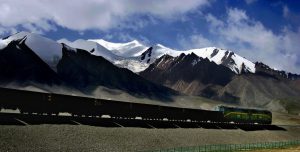
Head for Yangpachen. Cross over the Lhachen La and stop at Damxung to have lunch. Afterwards drive about 2 hours along the Qinghai-Tibet Highway to Yangpachen. Yangpachen is 90 km to the north of Lhasa and is rich in terrestrial heat and densely distributed with various fountains, geysers, hot springs, boiling springs as well as hot-water lakes. It is a wonderful enjoyment to take a bath in an indoor swimming pool, which is supplied by fresh hot springs of Yangpachen. In the afternoon, drive back to Lhasa. Stay overnight in Lhasa.
Day 12 Lhasa airport dropping off (B)
Sightseeing and Activities:Lhasa airport dropping off
Accommodation:None
Meals:Breakfast
The driver will drop you off at the Lhasa airport in the morning to end the trip.
Recommended Hotels
| Destination | 5 Star | 4 Star | 3 Star |
| Lhasa | Luxury St. Regis Lhasa Resort | Lhasa Gang Gyan Hotel | Lhasa Xiongbala Hotel |
Service Included:
-
Tibet travel permit and all other necessary permits to Tibet;
-
All entrance ticket fees for all tourist sites listed in the itinerary;
-
Personal knowledgeable English-speaking Tibetan local tour guide;
-
Personal comfortable, clean and safe vehicle with reliable Tibetan local driver; vehicle ranging from 4WD land cruiser to minibus depending on your group size;
-
All lodging listed in the itinerary; it’s your decision about the accommodation class: luxury 5-star international hotel, comfortable 4-star hotel, economic 3-star hotel or budget hostel, guesthouse or tent. Please tell us your accommodation preference when submitting the enquiry; we will arrange the best-value hotels for you.
-
Domestic flight/train tickets listed in the itinerary;
-
All meals listed in the above itinerary.
Service Excluded:
-
International flight to and out of China;
-
Chinese visa (Note: we could help you with the Chinese visa application, like providing the invitation letter, presenting the hotel or domestic flight reservation copies, etc that you may need. )
-
Domestic flight/train not listed in the itinerary. (We can provide you the domestic flight/train ticket booking service at the BEST discount price; please contact us our travel experts for the details.)
-
Meals not specified in the itinerary; usually it costs about USD3-15 per person for one meal in TAR (Tibet Autonomous Region).
-
Tips and gratitude to tour guide and driver;
-
Personal expenses, like laundry, phone call, snacks, soft drinks (please do the best to avoid the alcoholic beverages during your Tibet trip), optional tour activities, etc.
Travel Tips:
- Tibet Permits
There are several permits required to visit Tibet. Tibet Entry Permit, issued by Tibet Tourism Bureau, is the most important one which has to be obtained before your trip because you must have it to take your flight/train to Tibet. To get the permit, you have to book a Tibet tour with us, and send us your passport and Chinese visa about 20 days in advance, and then let us apply for the permit (all Tibet permits can only be applied by travel agency). If you travel to other prefectures like Shigatse, Nyingchi, Shannan, etc, you also have to obtain an Alien Travel Permit. If you travel to Mount Everest, you have to obtain a Border Permit. (Tibet Discovery, with office in Lhasa, has always kept up with the latest news on Tibet Permits. Traveling with us, all your permits are guaranteed as long as you are qualified to the requirements.)
- Available Months to Visit Tibet
Generally speaking, May to early October is the best time to for a Mount Kailash trip. July and August are the peak season and rainy season. It may be too cold to travel in Kailash area from November to March. There is usually heavy snow. The conditions in Namtso Lake and Mount Everest area are quite similar with Kailash. While other places like Lhasa, Gyantse and Shigatse are suitable for travel all year around.
- High Altitude Sickness
The average altitude of Tibet is about 4000 meters above the sea level (Lhasa: 3700m; EBC: 5200m; Namtso: 4718m). You may suffer a bit from High Altitude Sickness in the beginning days of your Tibet trip if you haven’t had rich high plateau travel experience. But don’t worry too much, the high altitude can be acclimatized usually in 2~3 days. Our suggestion is to take a physical examination and get suggestions from your doctor, and also bring some medicines to prevent from High Altitude Sickness before your trip. While in Tibet, you should keep warm all the time, avoid strenuous activities, drink more water and eat more vegetables and carbohydrates. You’d better not take showers during the first two days after your arrival at Tibet. If you don’t feel well, get help from your tour guide or go to the hospital without any delay.
- How to Go to Tibet
Basically you have two options – flight and train. Currently, you can take a flight to Lhasa from Beijing(4.5hrs), Xian(3.7hrs), Chengdu(2.5hrs), Chongqing(3hrs), Kuming(3hrs), etc. Among all these cities, Chengdu and Xian have more frequent flights to Lhasa. Kathmandu also has several flights to Lhasa each week.
If you a train travel, you can take a train to from Beijing(40.5hrs), Xian(32hrs), Chengdu(43hrs), Shanghai(47hrs), Chongqing(42hrs), Lanzhou(25hrs), Xining(22hrs), Guangzhou(54hrs).
- Packing and Wearing Ideas
Firstly you can’t forget your passport and Chinese Visa. A large backpack and a smaller one are recommended (the smaller one can be used for daily activities). Also bring the necessary medicine you need. Other stuffs like sunglasses, snow glasses, hats, lip balm, sun block are recommended. As for wearing, you are suggested to dress in layers (both thin and thick jackets). Down jacket is necessary in Spring and Autumn. A pair of durable and comfortable shoes is necessary.


![15 Days Tibet Mount Everest Advance Base Camp Trekking Adventure Tour [6340M]](https://mysterioustibet.com/wp-content/uploads/Mount-Everest-Base-Camp-in-Tingri-County-Tibet-13-300x200.jpg)














